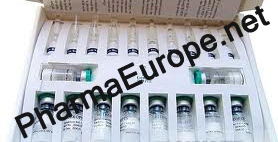|
Igtropin IGF1 LR3 100mcg*10

 |
|
 |
IGtropin
Active Ingredient: LongR3 IGF-1
Long R3 IGF-1 is an 83 amino acid analog of IGF-1 comprising the complete human IGF-1 sequence with the substitution of an Arg(r) for the Glu(e) at the position three, hence R3, and a 13 amino acid extension peptide at the N terminus. Thi9s analog of IGF 1 has been produced with the purpose of increasing he biological activity of the IGF peptide.
Long R3 IGF 1 is significantly more potent than IGF 1. The enhanced potency is due to the decreased binding of Long R3 IGF 1 to all known IGF binding proteins. These binding proteins normally inhibit the biological actions of IGF’s.
Biological Effects:
During puberty IGF is the most responsible for the natural muscle growth that occurs during these few years. There are many different things that IGF does in the human body; among the effects the most positive are increased amino acid transport to cells, increased glucose transport, increased protein synthesis, decreased protein degradation, and increased RNA synthesis.
When IGF is active it behaves differently in different types of tissues. In muscle cells proteins and associated cell components are stimulated. Protein synthesis is increased along with amino acid absorption. As a source of energy, IGF mobilizes fat for use as energy in adipose tissue. In lean tissue, IGF prevents insulin from transporting glucose across cell membranes. As a result the cells have to switch to burning off fat as a source of energy.
IGF also mimic’s insulin in the human body. It makes muscles more sensitive to insulin’s effects, so if you are a person that currently uses insulin you can lower your dosage by a decent margin to achieve the same effects, and as mentioned IGF will keep the insulin from making you fat.
Perhaps the most interesting and potent effect of IGF has on the human body is its ability to cause hyperplasia, which is an actual splitting of cells. Hypertrophy is what occurs during weight training, it is simply an increase in the size of muscle cells. See, after puberty you have a set number of muscle cells, and all you are able to do is increase the size of these muscle cells, you don’t actually gain more. But, wit IGF use you are able to cause this hyperplasia which actually increases the number of muscle cells present in the tissue, and through weight training you are able to mature these new cells, in other words make them grow and become stronger. So in a way IGF can actually change your genetic capabilities in terms of muscle tissue and cell count. IGF proliferates and differentiates the number of types of cells present. At a genetic level it has the potential to alter an individual’s capacity to build superior muscle density and size.
How to use:
The most effective length for a cycle of IGF is 50 days on and 20-40 days off.
Take dosages ranging from 60mcg up to 120 mcg per day in divided doses, one injection in the morning and again at bed time. Never exceed 120mcg in one day!
Do not use insulin for the nighttime injection of IGF 1. By taking insulin in the morning you prolong the IGF 1’s ? life to 12 hours.
Side effects:
The drug used in larger quantity around the 100+mcg range will cause headaches, occasional nausea and con contribute to low blood sugar or hypoglycemia in some users.
 Although the mechanisms underlying age associated muscle loss are not entirely understood, researchers attempted to moderate the loss by increasing the regenerative capacity of muscle. This involved the injection of a recombinant adeno-associated virus directing overexpression of insulin-like growth factor I (IGF-I) in differentiated muscle fibers. Although the mechanisms underlying age associated muscle loss are not entirely understood, researchers attempted to moderate the loss by increasing the regenerative capacity of muscle. This involved the injection of a recombinant adeno-associated virus directing overexpression of insulin-like growth factor I (IGF-I) in differentiated muscle fibers.
They demonstrated that the IGF-I expression promotes an average increase of 15% in muscle mass and a 14% increase in strength in young adult mice (Figure 1), and remarkably, prevents aging-related muscle changes in old adult mice, resulting in a 27% increase in strength as compared with uninjected old muscles (Figure 2). Muscle mass and fiber type distributions were maintained at levels similar to those in young adults. These results suggest that gene transfer of IGF-I into muscle could form the basis of a human gene therapy for preventing the loss of muscle function associated with aging and may be of benefit in diseases where the rate of damage to skeletal muscle is accelerated.
Discussion:
I’m not sure where to begin. This study has the potential to completely change the way we age.
In this experiment, a recombinant adeno-associated virus, directing overexpression of insulin-like growth factor I (IGF-I) in mature muscle fibers, was injected into the muscles of mice. The DNA that was originally in the virus was removed along with markers that stimulate immune response. DNA coding for IGF-1 was then put into the virus along with a promoter gene to ensure high rates of transcription. The results, as you can see by figures 1 & 2, were dramatic.
IGF-1 plays a crucial role in muscle regeneration. IGF-1 stimulates both proliferation and differentiation of stem cells in an autocrine-paracrine manner, although it induces differentiation to a much greater degree. IGF-1, when injected locally, increases satellite cell activity, muscle DNA, muscle protein content, muscle weight and muscle cross sectional area. The importance of IGF-1 lies in the fact that all of its apparent functions act to induce muscle growth with or without overload although it really shines as a growth promoter when combined with physical loading of the muscle.
IGF-1 also acts as an endocrine growth factor having an anabolic effect on distant tissues once released into the blood stream by the liver. IGF-1 possesses the insulin-like property of inhibiting degradation, but in addition can stimulate protein synthesis. The insulin-like effects are probably due to the similarity of the signaling pathways between insulin and IGF-1 following ligand binding at the receptors.
The ability of IGF-I to stimulate protein synthesis resembles the action of GH, which was shown in separate studies on volunteers to stimulate protein synthesis without affecting protein degradation. Although it is often believed that the effects of GH are mediated through IGF-1, this cannot be the case entirely. First, the effects of the two hormones are different, in that GH does not change protein degradation. Second, the effect of GH is observed with little or no change in systemic IGF-1 concentrations. Age related muscle loss has been prevented with GH injections, however it is believed that this is accomplished through IGF-1.
The results of this study are similar to other studies where IGF-1 was injected directly into muscle tissue, resulting in increases in size and strength of experimental animals. Using a virus as a genetic vehicle has an advantage over simply injecting the growth factor. The effects of a single viral treatment last significantly longer (months if not years) because the muscle cell itself is constantly overproducing its own IGF-1 from injected DNA.
The fact that the IGF-1 produced by the muscle of these mice did not reach the blood stream is interesting. Systemic injections of IGF-1 have not been successful in inducing this kind of anabolic effect in humans. In addition, IGF-1 produced by the liver is genetically different than that produced by muscle tissue. It could be that providing additional DNA for the muscle to produce it’s own IGF-1 is the key to achieving anabolic and rejuvenative effects specifically in skeletal muscle.
In this study there was a preferential preservation of type IIb muscle fibers in aging mice. These are the fibers most sensitive to muscle hypertrophy from training and they are also the first fibers to disappear with aging. In the mice receiving the engineered virus, there was also a preservation of the motor neuron, leading to an increase in functional capacity. It is speculated that age related muscle loss is secondary to the loss of neuronal activation of type-II fibers. By preventing the degeneration of typ-II motor units, functional capacity could be maintained into old age. This technique may also serve useful in the prevention of osteoporosis. Further study is necessary to determine wether IGF-1 is having an effect only on muscle fibers or on nervous tissues as well.
Finally, it was also exciting to see muscle growth in the young mice who received the injection (15% increase in muscle mass). This means that the injection provided levels of IGF-1 far and above what the muscle normally has access to and not simply a preservation of normal levels. Remember that this was not combined with exercise. The growth of the injected muscles happened even without an extreme mechanical stimulus. The mice were simply allowed to run around as they usually do. Because of these dramatic results, the authors expressed concern about the use of this technique to enhance performance or cosmetic appearance. Research Update is not my personal soap box so I won’t go off on the gender centered hypocrisy of cosmetic enhancement in our society. All we can hope for is that this technique will be used to treat more important diseases such as muscular dystrophy and thereby become somewhat available for other uses as well.
|





